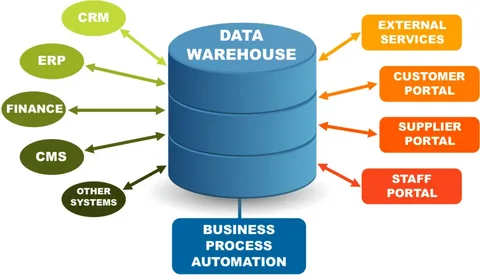Education Data Warehouse: The Ultimate Guide
Outline
- Introduction
- What is an Education Data Warehouse?
- Why is it Important?
- The Basics of Education Data Warehouses
- Key attributes
- How It Works
- Benefits of Using an Education Data Warehouse
- Improved Data Management
- Enhanced conclusion-Making
- Streamlined Reporting
- How to Implement an Education Data Warehouse
- Planning and groundwork
- Choosing the Right Tools
- Data Integration and Migration
- Common Challenges and How to Overcome Them
- Data Quality Issues
- Technical Difficulties
- Change Management
- Future Trends in Education Data Warehouse
- Big Data and Analytics
- AI and Machine Learning
- Increased Data Security
- Common Questions About Education Data Warehouses
- What Are the Costs Involved?
- How Can Small Schools Benefit?
- Conclusion
- Recap of Key Points
- Encouragement to Embrace Data Warehouse
Introduction
Have you ever wondered how schools handle all their information, including student records such as attendance, grades, and much more?
It’s an intricate job and that’s why the Education Data Warehouse comes into the equation.
The Education Data Warehouse is powerful software designed to gather, organize, and analyze huge amounts of data related to education.
In this article, we’ll discuss the reasons why it’s important, how it functions, and how it can change the way your school manages data.
The Basics of Education Data Warehouses

Key aspects
What is it that makes the Education Data Warehouse stand out?
Here are some of the most important characteristics:
- Centralized Storage for Data Your data will be saved in one location and is easy to find and control.
- Data Integration This combines the data of multiple sources—such as students’ information systems and learning management systems—into one coherent view.
- Advanced Analytics: provides tools to analyze data, create reports, and make data-driven choices.
How It Works
Visualize your educational data warehouse in the form of a huge library in which every bit of student data is carefully cataloged.
Here’s an easy explanation of how it functions:
- Data collection: Data from various sources is collected and then imported to the storage warehouse.
- Data storage: Data collected is saved in a format that is structured, making it easy to access and utilize.
- Analyzing Data: The most sophisticated tools, algorithms, and software analyze the data to identify trends and provide insights.
- reporting: Results are presented in dashboards and reports, aiding educators in making educated decisions.
Benefits of Using an Education Data Warehouse
Improved Data Management
The management of data across multiple applications can create a challenge.
The Education Data Warehouse simplifies this by centralizing your data.
Benefits include:
- Quick Access Find quickly the information you require without having to sift between several systems.
- Congruity: Check that every piece of data is up-to-date and accurate.
Enhanced Choice-Making
With all your information all in one place, making decisions is more simple.
Here’s how:
- Data-Driven Insights look at patterns and trends to make educated decisions.
- Reliable Reporting You can access up-to-date data to resolve issues quickly.
Streamlined Reporting
The process of creating reports can be lengthy.
A education data warehouse automates this process, thereby saving you time as well as effort.
- Flexible Reports: Create reports tailored to your specific needs.
- Automatic Updates The reports are updated in real time as new information comes in.
How to Implement an Education Data Warehouse

Planning and planning
Before you begin, it is crucial to think about your plan of attack.
Here’s how you can get started:
- Define Goals: Clearly outline what you hope to attain by using the warehouse.
- Assess the requirements: measure the types of data you’ll need to archive and analyze.
Choosing the Right Tools
Choosing the right tools is crucial to ensuring the success of your implementation.
Take a look at these options:
- Software Solutions: Look for reliable software that meets your requirements.
- Support for Vendors: Choose a vendor with a solid support system and training.
Data Integration and Migration
Integrating data into your new system requires:
- Data Mapping Discover how the data coming from different sources can be incorporated inside the Warehouse.
- Data Migration Data is transferred from older platforms to the latest system for completeness and accuracy.
Common Challenges and How to Overcome Them
Data Quality Issues
A high-quality data set is crucial to warrant a precise analysis.
To tackle these issues:
- Periodic Audits Regularly check your data to warrant the accuracy of the data.
- Clean Data Correct or remove any outdated or incorrect information.
Technical Difficulties
Technical issues can develop when setting up.
Here’s how to deal with these issues:
- Expert Assistance: Engage with IT experts or consultants to get assistance.
- Test thoroughly: Test the system thoroughly prior to going live.
Change Management
Implementing a new system could be a challenge for employees.
To deal with this:
- Education: Provide comprehensive training for all users.
- Transparent Communication Inform everyone about the latest developments and advantages.
Future Trends in Education Data Warehouse

Big Data and Analytics
The future of data is focused on big data and sophisticated analytics.
Look for more advanced tools to analyze large volumes of data and reveal more insight.
AI and Machine Learning
Artificial Intelligence and Machine Learning have revolutionized the way we analyze data.
These tools are able to predict patterns, automate tasks, and enhance learning experiences.
Increased Data Security
As data is becoming much more central, security becomes essential.
The future trends will concentrate on:
- Improved Secure Measures Data protection from attacks and unauthorized access.
- Compliant: Ensuring compliance with laws on protection of data.
Common Questions About Education Data Warehouses
What Are the Costs Involved?
Costs may vary depending on:
- Dimensions and scope Systems that are larger or those that have advanced features might cost more.
- Vendor Pricing varies between various software providers.
Be aware of both the initial setup cost and ongoing maintenance costs when preparing your budget.
How Can Small Schools Benefit?
Even schools with a small size could receive substantial benefits, like:
- Improved Data Management Centralized data helps to manage it.
- enhanced report: Streamlined reporting processes reduce time and effort.
Conclusion
A data warehouse that stores education information could be a game changer for schools.
Through centralizing data, enhancing reporting, and increasing decision-making, it creates the foundation for improved educational outcomes.
If you’re looking to elevate your school’s data management into the future, you should consider the purchase of an education data warehouse.
Be open to change and reap the benefits of simplified decisions based on data.




